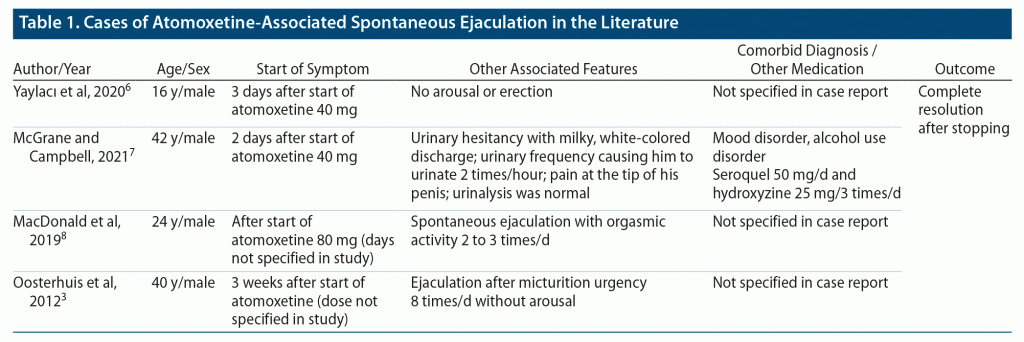
Prim Care Companion CNS Disord 2022;24(3):21cr03136
To cite: Rizvi A, Srinivas S, Jain S. Spontaneous ejaculation associated with atomoxetine. Prim Care Companion CNS Disord. 2022;24(3):21cr03136.
To share: https://doi.org/10.4088/PCC.21cr03136
© Copyright 2022 Physicians Postgraduate Press, Inc.
aDepartment of Psychiatry, Texas Tech University Health Science Center at Permian Basin, Odessa, Texas
bAJ Institute of Medical Sciences and Research Center Mangalore, Karnataka, India
*Corresponding author: Abid Rizvi, MD, Texas Tech University Health Science Center, 2301 W Michigan Ave, Midland, TX 79701 (abidrizvi021@gmail.com).
Atomoxetine is US Food and Drug Administration approved to treat attention-deficit/hyperactivity disorder (ADHD) in children, adolescents, and adults. It acts through selective norepinephrine reuptake inhibition.1
Sexual side effects with atomoxetine reported in adults include erectile dysfunction, dysmenorrhea, ejaculation delayed/ejaculation disorder, and decreased libido.2 In addition, spontaneous ejaculation with or without sexual arousal is associated with many psychotropics, including venlafaxine, methylphenidate, and amphetamine.3 We share our unique experience with a case of spontaneous ejaculation related to atomoxetine, its presentation, and its clinical course, which we think will be helpful for many clinicians.
AnchorCase Report
The patient was a 39-year-old medically healthy White man who met DSM-5 criteria for adult ADHD. He had no other psychiatric or medical diagnosis. The only psychotropic he had ever taken was methylphenidate for ADHD, which was started at age 10 years. He denied any adverse effects from methylphenidate, but stopped taking it at age 24, as he thought he had grown out of ADHD. The patient was a social drinker with 1 to 2 beers on the weekend and denied having used any other drugs. He lived with his wife and 2 kids, was sexually active, and experienced no sexual problems at baseline. He was employed with a large company. Physical and mental status examinations were unremarkable. His body mass index was 35 kg/m2, blood pressure was 125/78 mm Hg, and baseline laboratory results, including complete blood count, liver function, kidney function test, and thyroid-stimulating hormone, were within the normal range. His urine drug screen was negative. The patient wanted to try a nonstimulant. So, he was started on atomoxetine 40 mg, which was increased to 80 mg in 1 week.
At 1-month follow-up, the patient reported that after 2 days of starting atomoxetine, he started ejaculating without erection once a day when he was awake. The patient stated that masturbation, porn viewing, sensual/erotic thoughts in his mind, or sexual activity did not precede these ejaculations. Instead, the patient experienced these ejaculations as involuntary and with no orgasmic sensations. These spontaneous ejaculations increased in frequency with an increase in the atomoxetine dose to 80 mg/d. Eventually, he experienced such ejaculations 2 to 3 times a day. The patient felt embarrassed because these ejaculations often happened suddenly in social situations. Nevertheless, the patient remained sexually active with his wife and denied any sexual dysfunction. Urogenital consultation revealed no abnormality.
We recommended stopping the atomoxetine with follow-up in 1 week. The spontaneous ejaculation stopped after 5 days of discontinuing atomoxetine. We started the patient on methylphenidate extended release 18 mg. At 1-month follow-up, he reported that he had not experienced spontaneous ejaculation with methylphenidate.
AnchorDiscussion
The sympatric system regulates ejaculation latency time. Ejaculation has an emission and expulsion phase and is controlled by the autonomic nervous system.4 Atomoxetine induces adrenergic activity by inhibiting the reuptake of norepinephrine, leading to decreased ejaculatory latency and inducing spontaneous ejaculation.5
There are similar cases in the literature (Table 1).6–9 Spontaneous ejaculation started shortly after starting atomoxetine, and there was complete resolution after its discontinuation. Our case is unique because the patient had no comorbid medical or psychiatric diagnosis and was not on any other medication, and the frequency of spontaneous ejaculation increased with the increase in dose of atomoxetine, making the relationship between the drug and adverse effect more likely. We used the Naranjo Adverse Drug Reaction Probability Scale,10 which had a score of 7 interpreted as “probable.”
In 3 of 4 cases reported in the literature, the patients had no orgasm associated with ejaculation, while one had an orgasm.6–9 Orgasm with ejaculation requires activation of different neuronal circuits. This case shows that ejaculation can occur with no orgasm. However, we are at a loss to explain why the patient did not have spontaneous ejaculation with amphetamine and methylphenidate despite affecting similar neurochemicals.
Published online: May 24, 2022.
Relevant financial relationships: None.
Funding/support: None.
Patient consent: Informed consent was received from the patient to publish the case report, and information has been de-identified to protect anonymity.
References (10)

- Strattera (atomoxetine) [package insert]. Lilly LLC; 2020.
- Clemow DB, Bushe C, Mancini M, et al. A review of the efficacy of atomoxetine in the treatment of attention-deficit/hyperactivity disorder in children and adult patients with common comorbidities. Neuropsychiatr Dis Treat. 2017;13:357–371. PubMed CrossRef
- Oosterhuis I, Heijting L, Van Puijenbroek EP. Spontaneous ejaculation with the use of ADHD drugs. Drug Saf. 2009;32(10):409.
- Clement P, Giuliano F. Physiology and pharmacology of ejaculation. Basic Clin Pharmacol Toxicol. 2016;119(suppl 3):18–25. PubMed CrossRef
- Sivrioglu EY, Topaloglu VC, Sarandol A, et al. Reboxetine induced erectile dysfunction and spontaneous ejaculation during defecation and micturition. Prog Neuropsychopharmacol Biol Psychiatry. 2007;31(2):548–550. PubMed CrossRef
- Yaylacı F, Şahbudak B, Küçük Ö. Spontaneous ejaculation induced with atomoxetine. Psychopharmacol Bull. 2020;50(1):40–43. PubMed
- McGrane IR, Campbell TJ. Probable genitourinary adverse events associated with atomoxetine in an adult male: a case report. J Pharm Pract. 2021;34(6):962–965. PubMed CrossRef
- MacDonald T, Wimalaguna PS, Akosile W. Case report: severe and treatment-resistant spontaneous ejaculation secondary to atomoxetine. Australas Psychiatry. 2019;27(2):198–199. PubMed CrossRef
- Oosterhuis I, Heijting L, van Puijenbroek E. Spontaneous ejaculation with the use of noradrenergic reuptake inhibitors. Eur J Clin Pharmacol. 2012;68(10):1461–1462. PubMed CrossRef
- Naranjo CA, Busto U, Sellers EM, et al. A method for estimating the probability of adverse drug reactions. Clin Pharmacol Ther. 1981;30(2):239–245. PubMed CrossRef
Please sign in or purchase this PDF for $40.


